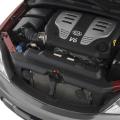Capable of working to the limit
Real synthetics will always easily withstand both frost and heat. This is the oil for LIQUI MOLY Synthoil High Tech 5W50 cars. Its temperature range is from minus 35 to plus 50 degrees Celsius!
Product Description
Liquid Moli Sintoil High Tech 5W50, as the name suggests, is a fully synthetic lubricant. It is created on a high-quality artificial basis with the latest additive package.
This oil is designed for the longest possible drain interval. It provides easy pumping in cold and hot weather, uniform lubrication of rubbing engine parts. Cleans them from carbon deposits, preventing aging and wear. Thus, it significantly extends the engine life.
Application area
Liquid Moli Synthoil High Tech 5W50 is designed for light vehicles. Used in new engines, including multivalve, gasoline and diesel engines. Turbocharged compatible. Ideal for long drain intervals and high stress.

Specifications
| Index | Test Method (ASTM) | Value | unit of measurement | |
|---|---|---|---|---|
| 1 | Viscosity characteristics | |||
| - | Viscosity grade | SAE J300 | 5W-50 | |
| - | Density at 15 ° C | DIN 51757 | 0.850 | g / cm³ |
| - | Kinematic viscosity at 40 ° C | ASTM D 7042-04 | 117 | mm² / sec |
| - | Kinematic viscosity at 100 ° C | ASTM D 7042-04 | 18.5 | mm² / sec |
| - | Viscosity index | DIN ISO 2909 | 170 | |
| - | Colour | DIN ISO 2049 | 3.5 | |
| 2 | Temperature characteristics | |||
| - | Flash point | DIN ISO 2592 | 238 | ° C |
| - | Pour point | DIN ISO 3016 | -39 | ° C |
Tolerances and conformities
- API: CF / SM;
- ACEA: A3 / B4.
Conformity:
- BMW: Longlife-98;
- MB: 229.3;
- Porsche: A40;
- VW: 502 00/505 00.

Release form and articles
- 9066 LIQUI MOLY Synthoil High Tech 5W-50 1L
- 9067 LIQUI MOLY Synthoil High Tech 5W-50 4L
- 9068 LIQUI MOLY Synthoil High Tech 5W-50 5L
- 9069 LIQUI MOLY Synthoil High Tech 5W-50 60L
- 9071 LIQUI MOLY Synthoil High Tech 5W-50 205L
Advantages and disadvantages
These are the significant advantages this lubricant has:
- the ability to change engine oil as rarely as possible;
- compatibility with other lubricants with similar properties;
- fast delivery to engine parts at low temperatures;
- overheating resistance;
- easy cold start;
- wide temperature range of use;
- oxidation stability;
- high cleansing properties;
- stable pressure;
- compatibility with modern engine systems;
- minimal presence of hazardous substances in the exhaust.
The disadvantages of this engine oil become apparent when used outside the manufacturer's specifications. In general, this is a quality product that meets all the manufacturer's statements and industry requirements.
Which oil is better than 5w20 or 5w50, water versus jelly.
Today we will conduct an interesting experiment and compare two Liquid Moli oils, determine their real differences.
At first glance, both products practically do not differ in anything, two varieties of synthetics, however, have serious differences and if the wrong choice is made, quite serious problems with the engine may arise, but more on that later.
We took such oils so that the differences in viscosity were significant.
If, for example, we take 5W-20 and 5W-30, then we will not notice much difference in the tests.
In our case, the difference should be significant. These oils, of course, cannot be compared - which is better or which is worse - since they are created for completely different engines.
Recall: the first number is winter viscosity, that is, viscosity in the cold; the second figure is the viscosity at 100 degrees Celsius, that is, the higher this figure, the thicker the oil at the engine operating temperature.
Oil viscosity test in the cold, in the cold
We will compare the first digit. In fact, it should be the same, we will find out in practice whether this is so.
To do this, we take test tubes, pour oil into them and place balls inside. Where the ball sinks faster, the oil is thinner in the cold. Let's start with an experiment in a warm place. It is immediately clear that the ball in the right test tube is moving faster, so 5W-20 is more liquid, now let's see if it's cold.

After the oils are frozen, the viscosity of 5W20 wins by a significant margin.
Here is a rebuttal for one of the incorrect statements, since many believe that in the cold they will move the same way, but as you can see from the test, this is not so.

Such a difference on Liquid Moli oils aroused interest, so we additionally took it and for comparison will also include it in the test.

So, first the test is warm. The most viscous was again 5W 20. We go into the cold.
So, 5W-20 again wins by a significant margin, and oddly enough, even Lukoil in the cold slightly outperforms 5W50.
As a result of the experiment, it turns out that the product with a viscosity of 5W-50 in the cold behaves exactly the same as 10W-40. Therefore, the second digit has a significant effect on viscosity.

Friction machine
The next test we will do on a friction machine and see which of these oils will have the most durable oil film.
The product 5W-20 showed a result of 13 kg, which indicates an excellent property of the oil in general.
5W-50 Withstood 12 kg, and such an excellent result was obtained as a result of the fact that the composition contains antifriction additives.
Oil volatility and ash test
Pour the same amount of oil into two cups, using a scale, and weigh it after heating. The ash content will be compared in trays. Pour oil into them and heat until complete evaporation, let's see what kind of bloom from the oil remains.
So, the oils warmed up for 2 hours and were weighed again. The 5W-20 had 75 grams. became 55 grams, 5W-50 also had 75, it became 59 grams, not much, but less evaporated.
Now let's look at the dry, unburned residue. As can be seen from the test, 5w20 has half the ash.
Such deposits remain on the surface of engine parts. These are mainly rings, which can cause the occurrence of rings and the deposition of ash on the particulate filter with just such a sludge.
Kinematic viscosity comparison
For this we have assembled a special device: it consists of two brass cylinders with cavities between them, they are lubricated with viscosity for uniform heating.
Also, a temperature sensor is installed between these cylinders, and the nozzle is a device that dispenses the optimal amount of liquid and gas.
First, fill in ordinary water to make sure that we have the same nozzles and start testing. Fill in oils in the same amount, heat them and see the difference in viscosity.
Here, as expected, 5W-20 picks up twice as fast and passes through the jet faster, therefore it has better circulation in the motor.
100 degrees is good, but how do you change the viscosity by 150 degrees?
For example, in highly loaded places the temperature can be even higher. Unfortunately, the thermometer is unable to detect temperatures above 110 degrees, so we will use a tester.
Now 5W-20 drains faster, but it also has a thinner lubricating film, but this must be compensated for by antifriction additives.
What kind of engine oil to fill - myths and reality
I also want to dispel one myth. Many car owners, especially sellers in a car shop, argue that it is necessary to fill in 5W-20 oil in a new car, after a small run of 5W30, and, after a serious run, fill in 5W-50, supposedly the engine clearances are increased and low viscosity may not be enough for full operation engine.
This opinion is erroneous. In addition to the gaps, there are also oil channels designed for viscosity, for example, 5W-20, therefore, oil with a high viscosity will not pump well through these channels.
The gaps may have increased, but the oil drainage channels remained the same or even decreased, and if you pour in a more highly viscous oil, then it will not have time to drain through these channels and, therefore, will hang in large quantities near the oil scraper ring, or even remain on the cylinder walls.
Accordingly, it will burn there and the amount of coke will increase.
This may cause a problem that many fear - the occurrence of oil scraper rings, therefore, if you fill in high-viscosity oil, it would seem that it should seal the rings, but in fact, at the time the engine is running, gas will pass through, which will burn out even more oil.
This will not lead to what you expected. Therefore, if you have 5W-20 oil in the tolerances, then pour it to the end, and you do not need to expose the car engine to unreasonable risk.
The test was attended by and.
The use of modern fully synthetic base oils (PAO) and advanced technologies in the development of additives guarantees low oil viscosity at low temperatures, high reliability of the oil film. Synthoil engine oils prevent the formation of deposits in the engine, reduce friction and reliably protect against wear. - Very high stability to elevated operating temperatures - Very low oil consumption - Rapid oil flow to all engine parts at low temperatures - High lubricity - Outstanding thermo-oxidative stability and aging resistance - Optimum engine cleanliness - Tested and compatible with catalysts and turbocharging Due to the fact that Synthoil is a real 100% PAO-synthetics, the use of these oils gives confidence in the stability of their protective properties even under conditions of temperature extremes, the use of low-quality fuel and exceeding the replacement period. The viscosity of 5W-50 allows you to more reliably protect the engine during overload.
Application
Miscible with oils of similar specifications. The engine oil must be changed in accordance with the vehicle operating instructions. Before replacing, it is recommended to flush the oil system by flushing the oil systems: http: //www..html Dispose of used oil in accordance with local regulations. Details in the "Safety data sheet".




